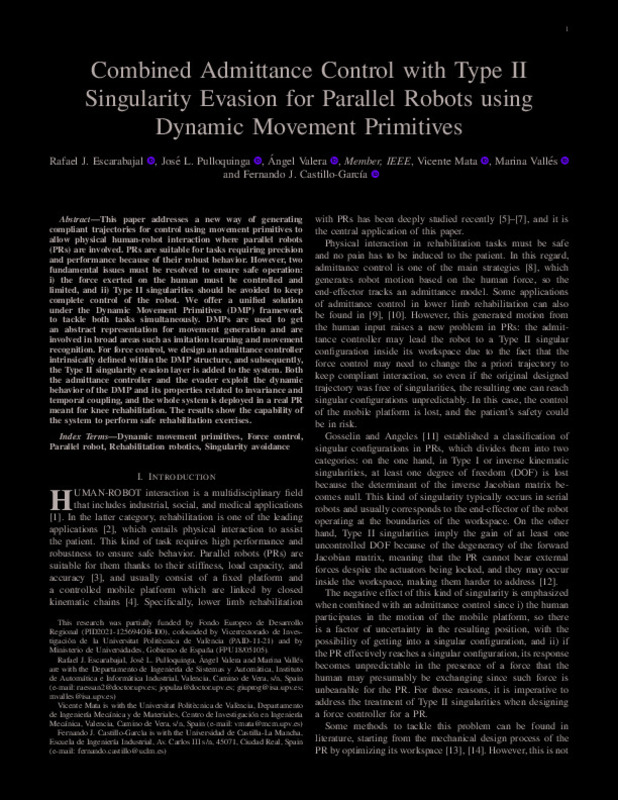JavaScript is disabled for your browser. Some features of this site may not work without it.
Buscar en RiuNet
Listar
Mi cuenta
Estadísticas
Ayuda RiuNet
Admin. UPV
Combined Admittance Control With Type II Singularity Evasion for Parallel Robots Using Dynamic Movement Primitives
Mostrar el registro sencillo del ítem
Ficheros en el ítem
| dc.contributor.author | Escarabajal-Sánchez, Rafael José
|
es_ES |
| dc.contributor.author | Pulloquinga-Zapata, José
|
es_ES |
| dc.contributor.author | Valera Fernández, Ángel
|
es_ES |
| dc.contributor.author | Mata Amela, Vicente
|
es_ES |
| dc.contributor.author | Vallés Miquel, Marina
|
es_ES |
| dc.contributor.author | Castillo-García, Fernando J.
|
es_ES |
| dc.date.accessioned | 2023-12-19T19:01:42Z | |
| dc.date.available | 2023-12-19T19:01:42Z | |
| dc.date.issued | 2023-06 | es_ES |
| dc.identifier.issn | 1552-3098 | es_ES |
| dc.identifier.uri | http://hdl.handle.net/10251/200923 | |
| dc.description.abstract | [EN] This article addresses a new way of generating compliant trajectories for control using movement primitives to allow physical human-robot interaction where parallel robots (PRs) are involved. PRs are suitable for tasks requiring precision and performance because of their robust behavior. However, two fundamental issues must be resolved to ensure safe operation: first, the force exerted on the human must be controlled and limited, and second, Type II singularities should be avoided to keep complete control of the robot. We offer a unified solution under the dynamic movement primitives (DMP) framework to tackle both tasks simultaneously. DMPs are used to get an abstract representation for movement generation and are involved in broad areas, such as imitation learning and movement recognition. For force control, we design an admittance controller intrinsically defined within the DMP structure, and subsequently, the Type II singularity evasion layer is added to the system. Both the admittance controller and the evader exploit the dynamic behavior of the DMP and its properties related to invariance and temporal coupling, and the whole system is deployed in a real PR meant for knee rehabilitation. The results show the capability of the system to perform safe rehabilitation exercises. | es_ES |
| dc.description.sponsorship | This work was supported in part by the Fondo Europeo de Desarrollo Regional under Grant PID2021-125694OB-I00, in part by the Vicerrectorado de Investigacion de la Universitat Politecnica de Valencia under Grant PAID-11-21, and in part by the Ministerio de Universidades, Gobierno de Espana under Grant FPU18/05105. | es_ES |
| dc.language | Inglés | es_ES |
| dc.publisher | Institute of Electrical and Electronics Engineers | es_ES |
| dc.relation.ispartof | IEEE Transactions on Robotics | es_ES |
| dc.rights | Reserva de todos los derechos | es_ES |
| dc.subject | Dynamic movement primitives (DMPs) | es_ES |
| dc.subject | Force control | es_ES |
| dc.subject | Parallel robot (PR) | es_ES |
| dc.subject | Rehabilitation robotics | es_ES |
| dc.subject | Singularity avoidance | es_ES |
| dc.subject.classification | INGENIERIA DE SISTEMAS Y AUTOMATICA | es_ES |
| dc.subject.classification | INGENIERIA MECANICA | es_ES |
| dc.title | Combined Admittance Control With Type II Singularity Evasion for Parallel Robots Using Dynamic Movement Primitives | es_ES |
| dc.type | Artículo | es_ES |
| dc.identifier.doi | 10.1109/TRO.2023.3238136 | es_ES |
| dc.relation.projectID | info:eu-repo/grantAgreement/ //FPU18%2F05105//AYUDA PREDOCTORAL FPU-ESCARABAJAL SANCHEZ. PROYECTO: DESARROLLO Y CONTROL DE ROBOTS PARALELOS RECONFIGURABLES PARA LA REHABILITACIÓN DE MIEMBRO INFERIOR DE PERSONAS/ | es_ES |
| dc.relation.projectID | info:eu-repo/grantAgreement/AEI//PID2021-125694OB-I00//SISTEMA ROBÓTICO PARALELO CON CONTROL BASADO EN MODELO MÚSCULO-ESQUELÉTICO PARA LA MONITORIZACIÓN Y ENTRENAMIENTO DEL SISTEMA PROPIOCEPTIVO/ | es_ES |
| dc.relation.projectID | info:eu-repo/grantAgreement/UPV-VIN//AYUDA PAID-11-21//Parallel rehabilitation robots: detection and control of singularities in the presence of manufacturing errors/ | es_ES |
| dc.rights.accessRights | Abierto | es_ES |
| dc.contributor.affiliation | Universitat Politècnica de València. Escuela Técnica Superior de Ingeniería del Diseño - Escola Tècnica Superior d'Enginyeria del Disseny | es_ES |
| dc.contributor.affiliation | Universitat Politècnica de València. Escola Tècnica Superior d'Enginyeria Informàtica | es_ES |
| dc.contributor.affiliation | Universitat Politècnica de València. Departamento de Ingeniería de Sistemas y Automática - Departament d'Enginyeria de Sistemes i Automàtica | es_ES |
| dc.contributor.affiliation | Universitat Politècnica de València. Escuela Técnica Superior de Ingenieros Industriales - Escola Tècnica Superior d'Enginyers Industrials | es_ES |
| dc.description.bibliographicCitation | Escarabajal-Sánchez, RJ.; Pulloquinga-Zapata, J.; Valera Fernández, Á.; Mata Amela, V.; Vallés Miquel, M.; Castillo-García, FJ. (2023). Combined Admittance Control With Type II Singularity Evasion for Parallel Robots Using Dynamic Movement Primitives. IEEE Transactions on Robotics. 39(3):2224-2239. https://doi.org/10.1109/TRO.2023.3238136 | es_ES |
| dc.description.accrualMethod | S | es_ES |
| dc.relation.publisherversion | https://doi.org/10.1109/TRO.2023.3238136 | es_ES |
| dc.description.upvformatpinicio | 2224 | es_ES |
| dc.description.upvformatpfin | 2239 | es_ES |
| dc.type.version | info:eu-repo/semantics/publishedVersion | es_ES |
| dc.description.volume | 39 | es_ES |
| dc.description.issue | 3 | es_ES |
| dc.relation.pasarela | S\494903 | es_ES |
| dc.contributor.funder | AGENCIA ESTATAL DE INVESTIGACION | es_ES |
| dc.contributor.funder | MINISTERIO DE CIENCIA E INNOVACION | es_ES |
| dc.contributor.funder | UNIVERSIDAD POLITECNICA DE VALENCIA | es_ES |







![[Cerrado]](/themes/UPV/images/candado.png)

